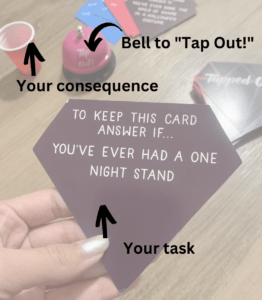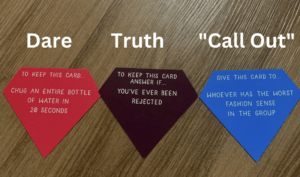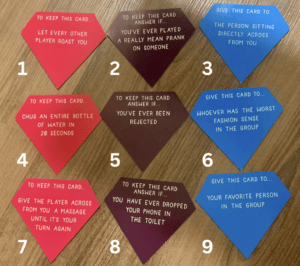Our Game
The game my team and I are designing is called PONG-ATHLON. Our game combines the mechanics of beer pong with the goal of finishing a set of challenges in order to win. There are 3 levels of challenges (easy, medium, and hard) that range across a set of 4 challenge categories which are denoted by cup color. Players take turns shooting the ball. If they make their ball into a cup, a member of the opposing team must complete the corresponding challenge. The team with the most cups wins. Currently, our challenges are mostly physical and involve the use of various household items. To investigate what it is like to engage in more social challenges, I choose to play Tapped Out.
What is Tapped Out?
Tapped Out is an adult party game with the same premise as the classic game, Truth or Dare. The mechanics of Tapped Out involve a set of color-coded cards corresponding to different challenges (pink denotes dares, purple denotes truths, and blue denotes “calling out” or “shouting out” other players), a bell to hit when you wish to “Tap Out!” of a challenge, and a shot glass to drink from as a consequence for “tapping out”.


What worked?
It was interesting to notice that the bell mechanic was not used by any of the players and, as a result, did nothing to help fine-tune the game’s dynamics. We all preferred to signal tapping out of a challenge by simply saying so and proceeding to fill the shot glass. As a designer, this observation serves as a reminder that while a mechanic may seem like a fun addition in theory, it may not be necessary in practice. It is important to narrow down what elements of the game actually contribute to making it fun. In contrast, the cards were the driving force in helping create meaningful dynamics between the players. The cards supported the Fellowship aspect of fun by getting players to reveal information they might have otherwise never shared. I particularly enjoyed how the information we were tasked with disclosing varied from sharing about our personal experiences (purple/truth cards) to sharing our thoughts about other players (blue/“call out” cards). The different card categories created a multi-dimensional dynamic between the players by creating opportunities for us to learn more about each other and learn more about how other people perceive us as individuals. You also have the pink/dare cards which help balance the game’s dynamic of self-disclosure of personal information with challenges that are physical and almost mindless with challenges like “Chug an entire bottle of water in 20 seconds”.
What didn’t work?
Now, I want to focus this discussion on the social challenge aspect of this game since my team’s game could benefit from the incorporation of such challenges. The aforementioned dynamics allowed players to laugh at themselves and laugh with one another overall creating a fun and playful aesthetic. However, there were moments where it felt like the game was inflicting harm with cards such as 6 and 1 in the figure below. These cards make it so that one person is the butt of the joke and the “fun” comes at the cost of damaging their self-esteem. These types of cards created small moments of tension in the group causing several players to wait anxiously for the card to be handed off. These cards are particularly interesting because a player can be awarded these “hurtful” cards and end up winning the game, but at what cost? The game mitigates these harms by giving players the option to “tap out” but to do so, they must take a shot. While it was fun to drink every time we tapped out, I think having such a limiting consequence is another flaw of the game because it gives players who wish to remain sober without a proper consequence. Since the game is based on points with 1 card = 1 point, one suggestion I have for a consequence is losing a card for every challenge you skip. This way, we emphasize the point mechanic of the game and give it another purpose.

Conclusion
Overall, I think that adding more social challenges to our game could improve the accessibility of our game given that it wouldn’t require as many props as it currently does. I also think it could create interesting dynamics between players that, at this point, do not exist in our game, if done well.



